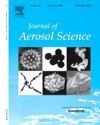ToF-SIMS analyses of brake wear particles in human epithelial Caco-2 cells
IF 2.9
3区 环境科学与生态学
Q2 ENGINEERING, CHEMICAL
引用次数: 0
Abstract
Air pollutants, especially fine particulate matter (diameter of <2.5 μm), are associated with severe health risks including increased cardiopulmonary and lung cancer mortality and development of neurodegenerative diseases. This study introduces a novel methodology that begins with in situ particulate pollution collection, proceeds to exposing non-animal human epithelial cell models which are then analyzed through high spatial resolution mass spectrometry imaging to differentiate the chemistry of particles among exposed cells. During regular train operations, brake wear particles (BWP) are primarily generated from brake pad abrasion. For this work, a custom train brake rig was used to generate BWP, which were then introduced to human epithelial Caco-2 cells. First, the BWP size distributions were characterized using an Electrical Low-Pressure Impactor and particles ranging from 1.1 to 2.7 μm were collected with a gravimetric impactor. A suspension of these BWP, characterized by Dynamic Light Scattering, was added to Caco-2 cells cultured on coverslips. After incubation, the cells were washed and fixed by freeze-drying to preserve the epithelial structure. Subsequent analyses with SEM and Time-of-Flight Secondary Ion Mass Spectrometry (ToF-SIMS) established substantial, partially agglomerated, BWP deposits on the surface of the epithelial cellular structures. Further analysis of the ToF-SIMS data using Multivariate Curve Resolution-Alternating Least Squares, achieved a better separation of underlying chemical distributions. This enhanced image contrast facilitated the observation of particle-cell interactions. The results demonstrate the efficacy and potential of ToF-SIMS mass spectrometry imaging in distinguishing and potentially characterizing particle-cell interactions. This methodology may be further refined by incorporating complementary analytical techniques such as ICP-MS to better quantify metal content in particles and attempts with smaller particles might help assess cellular particle penetration and accumulation.

人上皮Caco-2细胞制动磨损颗粒的ToF-SIMS分析
空气污染物,特别是细颗粒物(直径2.5 μm),与严重的健康风险有关,包括心肺和肺癌死亡率增加以及神经退行性疾病的发展。本研究引入了一种新的方法,从原位颗粒污染收集开始,接着暴露非动物人类上皮细胞模型,然后通过高空间分辨率质谱成像进行分析,以区分暴露细胞中颗粒的化学成分。在正常的列车运行过程中,制动磨损颗粒(BWP)主要是由刹车片磨损产生的。在这项工作中,使用定制的火车制动装置来生成BWP,然后将其引入人上皮Caco-2细胞。首先,使用低压冲击器对BWP的粒径分布进行了表征,并使用重力冲击器收集了1.1 ~ 2.7 μm的颗粒。将这些BWP的悬浮液添加到盖上培养的Caco-2细胞中,以动态光散射为特征。孵育后,将细胞清洗并冷冻干燥固定,以保存上皮结构。随后的扫描电镜和飞行时间二次离子质谱(ToF-SIMS)分析发现,上皮细胞结构表面存在大量部分凝聚的BWP沉积物。使用多元曲线分辨率-交替最小二乘法对ToF-SIMS数据进行进一步分析,可以更好地分离潜在的化学分布。这种增强的图像对比度有助于观察颗粒-细胞相互作用。结果证明了ToF-SIMS质谱成像在区分和潜在表征粒子-细胞相互作用方面的功效和潜力。该方法可以通过结合ICP-MS等互补分析技术进一步完善,以更好地量化颗粒中的金属含量,并且尝试使用较小的颗粒可能有助于评估细胞颗粒的渗透和积累。
本文章由计算机程序翻译,如有差异,请以英文原文为准。
求助全文
约1分钟内获得全文
求助全文
来源期刊

Journal of Aerosol Science
环境科学-工程:化工
CiteScore
8.80
自引率
8.90%
发文量
127
审稿时长
35 days
期刊介绍:
Founded in 1970, the Journal of Aerosol Science considers itself the prime vehicle for the publication of original work as well as reviews related to fundamental and applied aerosol research, as well as aerosol instrumentation. Its content is directed at scientists working in engineering disciplines, as well as physics, chemistry, and environmental sciences.
The editors welcome submissions of papers describing recent experimental, numerical, and theoretical research related to the following topics:
1. Fundamental Aerosol Science.
2. Applied Aerosol Science.
3. Instrumentation & Measurement Methods.
 求助内容:
求助内容: 应助结果提醒方式:
应助结果提醒方式:


